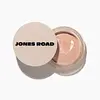What's inside
What's inside
 Key Ingredients
Key Ingredients

 Benefits
Benefits

 Concerns
Concerns

 Ingredients Side-by-side
Ingredients Side-by-side

Ethylhexyl Methoxycinnamate 3.9%
UV AbsorberTitanium Dioxide 3.3%
Cosmetic ColorantWater
Skin ConditioningDimethicone
EmollientButylene Glycol
HumectantGlycerin
HumectantCetyl Ethylhexanoate
EmollientCetyl PEG/PPG-10/1 Dimethicone
EmulsifyingNeopentyl Glycol Diheptanoate
EmollientDiphenylsiloxy Phenyl Trimethicone
Skin ConditioningTrehalose
HumectantTocopheryl Acetate
AntioxidantArgania Spinosa Kernel Oil
EmollientSodium Hyaluronate
HumectantSodium Dilauramidoglutamide Lysine
HumectantMagnesium Chloride
Pistacia Lentiscus Gum
MaskingGlycine
BufferingPEG/PPG-14/7 Dimethyl Ether
Skin ConditioningBupleurum Falcatum Root Extract
Skin ConditioningZanthoxylum Piperitum Peel Extract
AntimicrobialThymus Serpyllum Extract
Skin ConditioningSodium Acetylated Hyaluronate
HumectantRosa Roxburghii Fruit Extract
TonicAngelica Acutiloba Root Extract
Skin ConditioningHydrolyzed Conchiolin Protein
Skin ConditioningHydrolyzed Silk
HumectantPerilla Ocymoides Leaf Extract
TonicDextrin Palmitate
EmulsifyingPEG-9 Polydimethylsiloxyethyl Dimethicone
EmulsifyingAluminum Hydroxide
EmollientStearic Acid
CleansingTrisodium EDTA
Hydroxypropylcellulose
EmulsifyingPalmitic Acid
EmollientDimethylacrylamide
Alcohol
AntimicrobialDistearyldimonium Chloride
Triethoxycaprylylsilane
Synthetic Fluorphlogopite
Barium Sulfate
Cosmetic ColorantCaprylic/Capric Triglyceride
MaskingIsopropyl Alcohol
SolventBHT
AntioxidantSilica
AbrasiveTheanine
EmollientPhenoxyethanol
PreservativeChlorphenesin
AntimicrobialParfum
MaskingIron Oxides
Ethylhexyl Methoxycinnamate 3.9%, Titanium Dioxide 3.3%, Water, Dimethicone, Butylene Glycol, Glycerin, Cetyl Ethylhexanoate, Cetyl PEG/PPG-10/1 Dimethicone, Neopentyl Glycol Diheptanoate, Diphenylsiloxy Phenyl Trimethicone, Trehalose, Tocopheryl Acetate, Argania Spinosa Kernel Oil, Sodium Hyaluronate, Sodium Dilauramidoglutamide Lysine, Magnesium Chloride, Pistacia Lentiscus Gum, Glycine, PEG/PPG-14/7 Dimethyl Ether, Bupleurum Falcatum Root Extract, Zanthoxylum Piperitum Peel Extract, Thymus Serpyllum Extract, Sodium Acetylated Hyaluronate, Rosa Roxburghii Fruit Extract, Angelica Acutiloba Root Extract, Hydrolyzed Conchiolin Protein, Hydrolyzed Silk, Perilla Ocymoides Leaf Extract, Dextrin Palmitate, PEG-9 Polydimethylsiloxyethyl Dimethicone, Aluminum Hydroxide, Stearic Acid, Trisodium EDTA, Hydroxypropylcellulose, Palmitic Acid, Dimethylacrylamide, Alcohol, Distearyldimonium Chloride, Triethoxycaprylylsilane, Synthetic Fluorphlogopite, Barium Sulfate, Caprylic/Capric Triglyceride, Isopropyl Alcohol, BHT, Silica, Theanine, Phenoxyethanol, Chlorphenesin, Parfum, Iron Oxides
Water
Skin ConditioningCaprylic/Capric Triglyceride
MaskingC12-15 Alkyl Benzoate
AntimicrobialCaprylic/Capric/Succinic Triglyceride
EmollientPropanediol
SolventSimmondsia Chinensis Seed Oil
EmollientOlea Europaea Fruit Oil
MaskingCoco-Caprylate/Caprate
EmollientDiisostearyl Malate
EmollientC9-12 Alkane
SolventPolyhydroxystearic Acid
EmulsifyingHydrogenated Castor Oil
EmollientRicinus Communis Seed Oil
MaskingHelianthus Annuus Seed Wax
Skin ConditioningStearalkonium Hectorite
Gel FormingEuphorbia Cerifera Wax
Polyglyceryl-3 Diisostearate
EmulsifyingPolyglyceryl-3 Polyricinoleate
EmulsifyingPhenoxyethanol
PreservativeCopernicia Cerifera Wax
Silica Silylate
EmollientSodium Chloride
MaskingPelargonium Graveolens Oil
MaskingTocopheryl Acetate
AntioxidantPolyglyceryl-6 Polyricinoleate
EmulsifyingTriethoxycaprylylsilane
Zingiber Officinale Root Oil
MaskingLecithin
EmollientSilica
AbrasiveBiosaccharide Gum-1
HumectantSodium Hyaluronate
HumectantMica
Cosmetic ColorantCI 77891
Cosmetic ColorantIron Oxides
Citronellol
PerfumingGeraniol
PerfumingLinalool
PerfumingLimonene
PerfumingCitral
PerfumingWater, Caprylic/Capric Triglyceride, C12-15 Alkyl Benzoate, Caprylic/Capric/Succinic Triglyceride, Propanediol, Simmondsia Chinensis Seed Oil, Olea Europaea Fruit Oil, Coco-Caprylate/Caprate, Diisostearyl Malate, C9-12 Alkane, Polyhydroxystearic Acid, Hydrogenated Castor Oil, Ricinus Communis Seed Oil, Helianthus Annuus Seed Wax, Stearalkonium Hectorite, Euphorbia Cerifera Wax, Polyglyceryl-3 Diisostearate, Polyglyceryl-3 Polyricinoleate, Phenoxyethanol, Copernicia Cerifera Wax, Silica Silylate, Sodium Chloride, Pelargonium Graveolens Oil, Tocopheryl Acetate, Polyglyceryl-6 Polyricinoleate, Triethoxycaprylylsilane, Zingiber Officinale Root Oil, Lecithin, Silica, Biosaccharide Gum-1, Sodium Hyaluronate, Mica, CI 77891, Iron Oxides, Citronellol, Geraniol, Linalool, Limonene, Citral
 Reviews
Reviews

Ingredients Explained
These ingredients are found in both products.
Ingredients higher up in an ingredient list are typically present in a larger amount.
This ingredient is an emollient, solvent, and texture enhancer. It is considered a skin-softener by helping the skin prevent moisture loss.
It helps thicken a product's formula and makes it easier to spread by dissolving clumping compounds.
Caprylic Triglyceride is made by combining glycerin with coconut oil, forming a clear liquid.
While there is an assumption Caprylic Triglyceride can clog pores due to it being derived from coconut oil, there is no research supporting this.
Learn more about Caprylic/Capric TriglyceridePhenoxyethanol is a preservative that has germicide, antimicrobial, and aromatic properties. Studies show that phenoxyethanol can prevent microbial growth. By itself, it has a scent that is similar to that of a rose.
It's often used in formulations along with Caprylyl Glycol to preserve the shelf life of products.
Silica, also known as silicon dioxide, is a naturally occurring mineral. It is used as a fine, spherical, and porous powder in cosmetics.
Though it has exfoliant properties, the function of silica varies depending on the product.
The unique structure of silica enhances the spreadability and adds smoothness, making it a great texture enhancer.
It is also used as an active carrier, emulsifier, and mattifier due to its ability to absorb excess oil.
In some products, tiny microneedles called spicules are made from silica or hydrolyzed sponge. When you rub them in, they lightly polish away dead skin layers and enhance the penetration of active ingredients.
Learn more about SilicaSodium Hyaluronate is hyaluronic acid's salt form. It is commonly derived from the sodium salt of hyaluronic acid.
Like hyaluronic acid, it is great at holding water and acts as a humectant. This makes it a great skin hydrating ingredient.
Sodium Hyaluronate is naturally occurring in our bodies and is mostly found in eye fluid and joints.
These are some other common types of Hyaluronic Acid:
Learn more about Sodium HyaluronateTocopheryl Acetate is AKA Vitamin E. It is an antioxidant and protects your skin from free radicals. Free radicals damage the skin by breaking down collagen.
One study found using Tocopheryl Acetate with Vitamin C decreased the number of sunburned cells.
Tocopheryl Acetate is commonly found in both skincare and dietary supplements.
Learn more about Tocopheryl AcetateTriethoxycaprylylsilane is a silicone used to bind and stabilize ingredients.
As an emulsifier, it helps prevent ingredients from separating. This can help elongate the shelf life of products.
Triethoxycaprylylsilane is often used to coat mineral sunscreens ingredients to help give a better feel. It also helps reduce oxidative stress in sunscreens.
Learn more about TriethoxycaprylylsilaneWater. It's the most common cosmetic ingredient of all. You'll usually see it at the top of ingredient lists, meaning that it makes up the largest part of the product.
So why is it so popular? Water most often acts as a solvent - this means that it helps dissolve other ingredients into the formulation.
You'll also recognize water as that liquid we all need to stay alive. If you see this, drink a glass of water. Stay hydrated!
Learn more about WaterThis ingredient is a combination of red, black, and yellow iron oxide pigments. This combination of colors is usually found in foundation, because it results in a "skin" color.